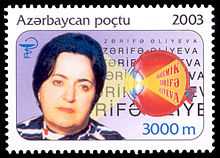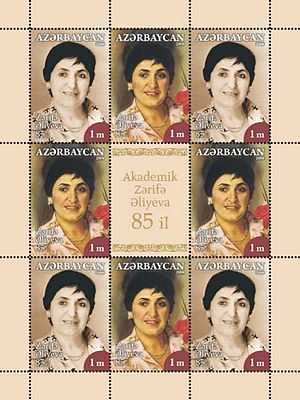Zarifa Aliyeva
| Zərifə Əliyeva | |
|---|---|
 | |
| Born |
April 28, 1923 Shakhtahkty village, Sharur, Azerbaijan SSR |
| Died |
April 15, 1985 (aged 61) Moscow |
| Residence |
|
| Fields | Ophthalmology |
| Institutions | National Academy of Sciences of the Azerbaijan SSR |
| Notable awards | Premium named after M.I.Averbakh |
Zarifa Aziz gizi Aliyeva (Azerbaijani: Zərifə Əziz qızı Əliyeva; April 28, 1923, Shakhtahkty village, Sharur, Azerbaijan SSR – April 15, 1985, Moscow) was an Azerbaijani ophthalmologist, academician of the National Academy of Sciences of Azerbaijan and professor.[1]
Zarifa Aliyeva is the author of 14 monographs and hundreds of research papers, 12 rationalization proposals. Her father was Aziz Aliyev – People’s commissar of public health services of the Azerbaijan SSR, later the first secretary of the Communist party’s oblast committee of Dagestan. Zarifa Aliyeva was the wife of third president of Azerbaijan Heydar Aliyev and the mother of fourth president of Azerbaijan Ilham Aliyev.
Main part of Zarifa Aliyeva’s activity was related to Azerbaijan State Institute of Advanced Medical Studies.[2]
Biography
In 1948, she married Heydar Aliyev. On October 12, 1955, was born their daughter Sevil, and on December 24, 1961, their son Ilham.
She enjoyed authority over Azerbaijan and the USSR. She devised and introduced new methods for treatment of ocular diseases.
In 1982, she lived in Moscow with her family. In 1985, died of cancer and was buried in Moscow. And later, in 1994, her remains were reburied in the Alley of Honor, Baku.
Memory

Postage stamps dedicated to Zarifa Aliyeva were released in 2003, 2008 and 2013.
Awards
Superior award in the sphere of ophthalmology – Premium named after M.I.Averbakh- professor of medical studies.
Books
•Anatomico-physiological features of hydrodynamic system of eye.
•Age-caused changes in eye and optic nerve passages: (Morfohistochemical researches) (in co-authorship). Baku, 1980.
•Professional pathology of eyesight (in co-authorship), 1988.
•Modern surgical methods in the treatment of epiphora .
•Lachrymal physiology.
•Sparing surgery in the treatment of the lacrimal passages.[3]